In my last blog, I wrote that one of my teaching tasks is mentoring small businesses in the Portland Metro area, and about my role helping local craft brewers improve their cash flows.
The master brewers have pretty good control of the Supply side of the equation. Their response times are relatively quick, their product quality is good and they are generally aware of the production costs. But the Demand side of the equation is a much greater challenge. Should they sell entirely out of the tap room or should they use distributors? Do they take their product to other markets or geographies to increase demand? With little planning or use of a cost-to-serve model, decisions are often made without regard to what will happen to cash and cash flow. In this line of business (which is typically either highly leveraged in debt or has an infusion of money from family members,) cash is king.
As a way of providing the benefit of my experiences to small businesses that struggle with this subject, I’m now focusing on how Demand can be planned in small-to-medium-sized businesses. Granted, all of the same elements that exist in giant multi-national companies are present in these smaller organizations, but they simply don’t have the staff or time to run a full SIOP (Sales, Inventory and Operations Planning) process. Therefore, we will continue to explore this question:
How does a small business go about its planning?
On the subject of Demand Planning, I would like to first acknowledge people like Mark Moon and Paul Dittmann from the University of Tennessee, the late Tom Mentzer (also from UT), as well as Andrew Lewis, John Hellriegel and Anne Bruggink who worked for me at Honeywell, and Ken Carlson who I worked with at John Deere. These are the true experts in this area, and most of what I’ve learned over the years came from them.
Portfolio Management
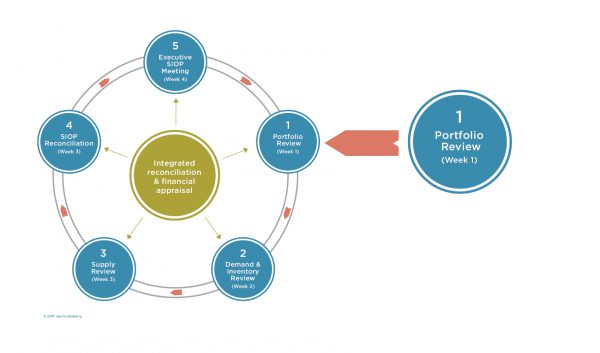
The bullets below summarize my last blog’s discussion of Portfolio Management and New Product Introductions:
- Supply chain complexity directly correlates to portfolio complexity
- Product portfolio management begins with the life of a product or service and ends with the elimination of the SKU
- Engineering, marketing, sales, demand management and sourcing should own the beginning and end-of-life of a product or service
Additionally:
- New Product Introduction is part of portfolio management, which is a de facto part of the Demand Plan and SIOP
- Demand profiles are generated to support phase-in and phase-out of products and services
- Launch strategy and assumptions have to be understood by everyone, including the leadership team
- Order profile or make-to-stock vs. make-to-order
- Customer service requirements
- Cannibalization / replacement assumptions
- Timelines, volumes, manpower
- Risk identified with issuance of an issues log that is included in the demand review
Finally, the goals of a Portfolio Review are:
- To define the products and services offered to customers
- To manage those offerings throughout their lifecycle
- Product development pipeline
- Up to three years of demand history
- A volume and dollar-based plan for portfolio changes
- An SKU rationalization plan
- A customer service strategy for each SKU in the portfolio
Demand Planning
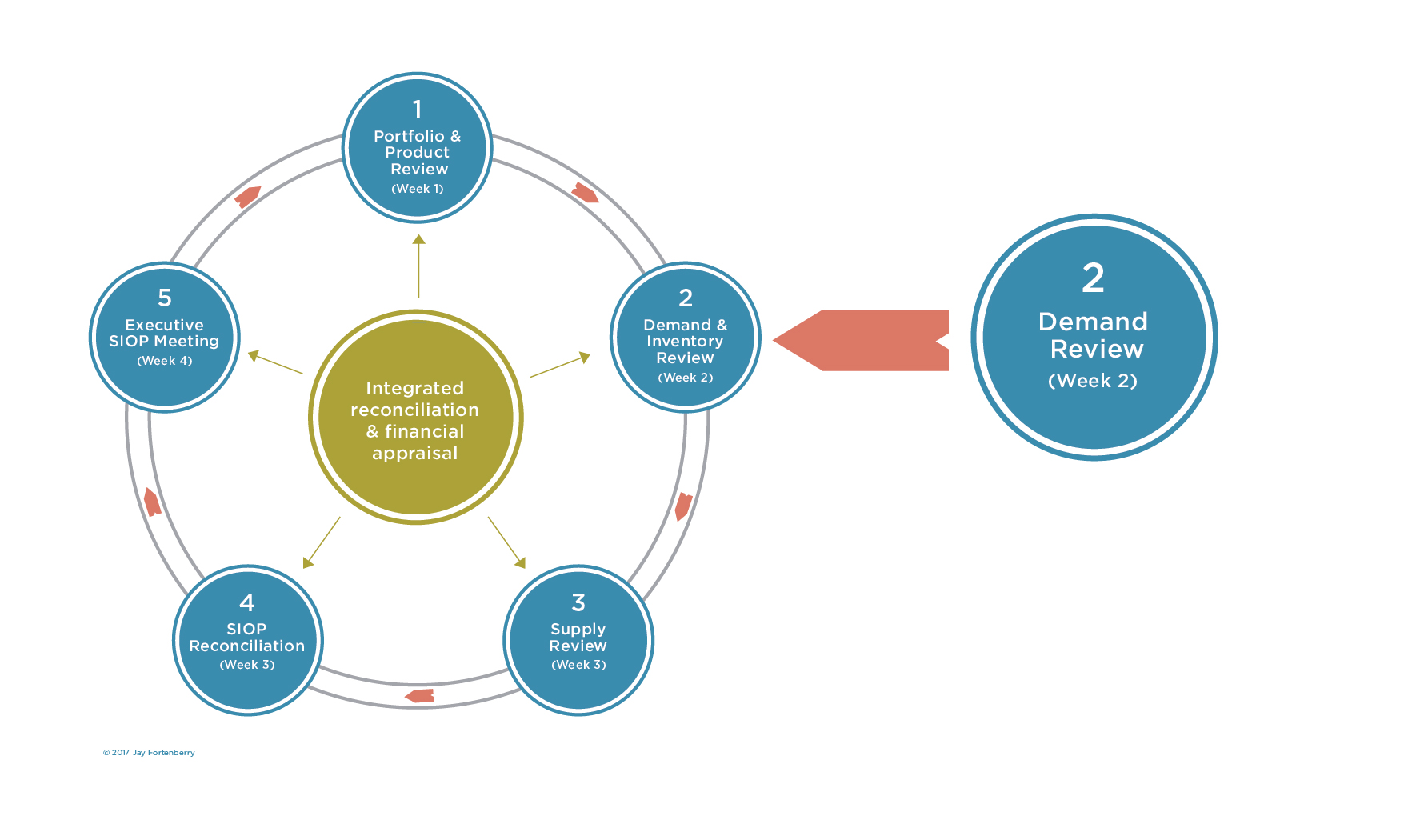
At its most basic, a demand plan is a realistic view of future sales based on all known activities and trends. It is also the main business process that anticipates and acts on a changing business outlook:
- Review of product portfolio, understanding lifecycle and implications
- Planning future demand, considering risks and opportunities
- Developing a supply response and the ability to react to changes
- Reconciling all plans with financial assessment of risk and trade-offs
- Team decisions presented to executives for review and agreement
The demand plan is used by Sales and Marketing to focus or change the commercial direction of the business. Additionally, it is a formal request for the Supply Chain to make the relevant materials and schedule capacity for anticipated customer requirements. Finally, the demand plan is a financial commitment made by the business for top line revenue and bottom line margin.
For a greater context:
- Demand is what customers would buy if they could. This is unconstrained demand.
- The Demand Forecast is a projection into the future of expected demand given a stated set of environmental assumptions. This is an unconstrained forecast.
- Outputs are the managerial actions that result from the balancing of demand with supply, including:
- Operational plans
- Demand plans
- Revenue plans
The nature of a business determines the nature of the Demand Plan.
- Narrow
- Broad
- Regional
- Global
- Age
- Quality
- NPI
- Seasonal demand
- Shelf life
- Recipe
- Resources
- Education/training
Additionally, a process that works best for one business might not work for another.
Forecasting
“The only function of economic forecasting is to make astrology look respectable.”
John Kenneth Galbraith
Canadian-American Economist and Author
I once attended a supply chain forum at the University of Tennessee, where the president of a very well-known consumer electronics company said, “My sales force turned out to be the world’s worst forecasters, but the world’s best adjusters.”
I always thought this was a great statement on the art of forecasting. The goal of the forecasting process is to provide an ongoing, sustainable 12-to-18-month forecast for the business that uses the collaboration of sales and product management knowledge based on historical actuals. It also uses the future expectations of existing and new customers for both existing and new product listings.
The objective is to:
- Provide an accurate forecast of unconstrained product demand by product listing quantity with 12-to-18-month visibility
- Overlay with market intelligence, trends and exceptions
A forecast is the basis for all planning decisions in a supply chain and is used for both push and pull processes. Additionally, forecasts are used for:
- Production scheduling, inventory, and aggregate planning
- Sales force allocation, promotions, and new production introduction
- Plant/equipment investment and budgetary planning
- Workforce planning, hiring and layoffs
All decisions of this process are interrelated. Accuracy, honesty and integrity are essential in creating a forecast demand plan. Forecasts are always inaccurate and should thus include both the expected value of the forecast and a measure of forecast error. Long-term forecasts are usually less accurate than short-term forecasts, and aggregated forecasts are usually more accurate than disaggregated forecasts. In general, the farther up the supply chain a company is, the greater the distortion of information it receives.
Companies must identify the factors that influence future demand, then ascertain the relationship between these factors and future demand:
- Past demand
- Lead time of product replenishment
- Planned advertising or marketing efforts
- Planned price discounts
- State of the economy
- Actions that competitors have taken
Components and Methods of Forecasting are:
Qualitative
- Primarily subjective
- Rely on judgment
Time Series
- Use historical demand only
- Best with stable demand
Causal
- Relationship between demand and some other factor
Simulation
- Imitate consumer choices that give rise to demand
- Forecast error – Difference between the forecast and actual demand
Time Series Components looks backward at historical demand to try to identify future patterns by examining:
- Trend
- Continuing pattern of demand increase or decrease
- Pattern can be a straight line or a curve
- Seasonality
- Repeating pattern of demand increases or decreases
- Normally think of seasonality as occurring within a single year, and cycles as occurring over longer than one-year periods
- Noise
- Random fluctuation
- That part of demand history which the other time series components cannot explain
Some Demand Forecasting terminology is:
- Forecasting Level: At what level of granularity is the forecast expressed? (SKU, product, family, etc.)
- Forecasting Horizon: How far out into the future is demand forecast?
- Forecasting Interval: How frequently is the forecast updated?
- Forecasting Form: How is the forecast expressed? In units? Weight? Dollars?
Forecasting systems are not a silver bullet. The important points to remember are:
- You need a data warehouse to guarantee data integrity
- Your forecasting system must integrate “seamlessly” with other corporate systems
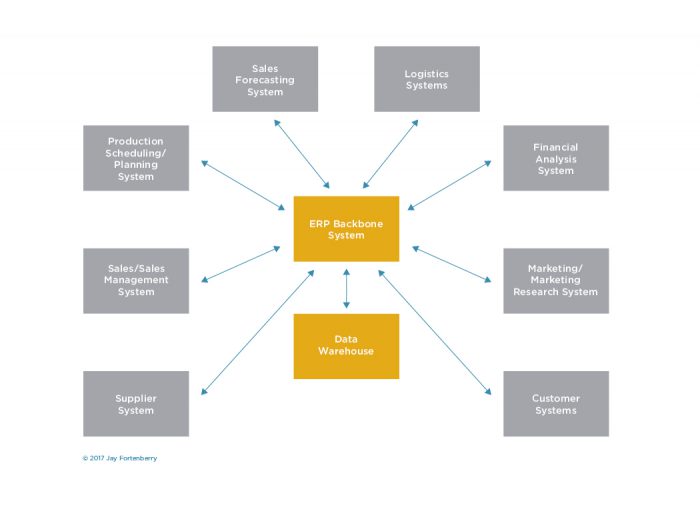
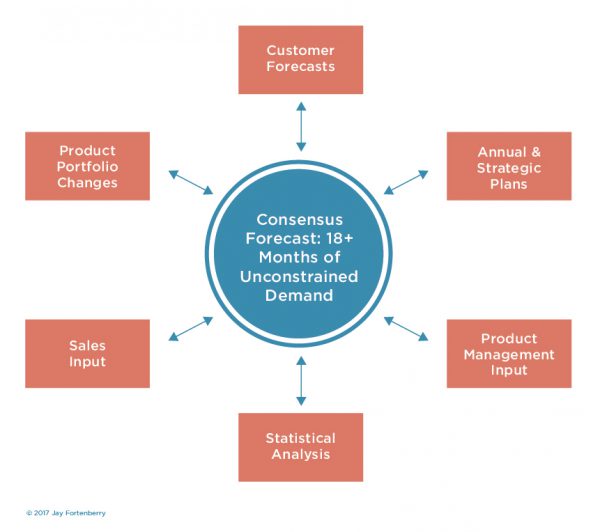
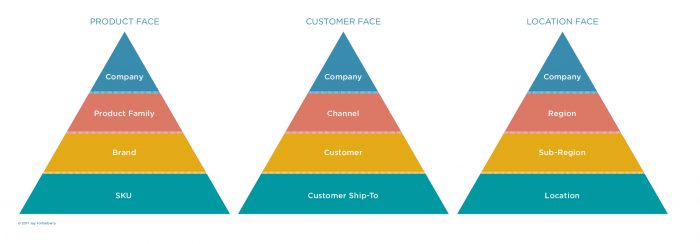
A Demand Planner puts information in at the level they know and takes it out at the level they need. Most basic forecasting software will have many algorithms embedded in it. Even so, the analyst should understand the idea behind what the time series techniques are doing.
Regression analysis is useful when:
- You think there are measurable factors that affect demand
- Demand is your Dependent Variable
- These measurable factors are your Independent Variables – which can either be internal or external
Examples of internal factors are:
- Promotional spending
- Advertising spending
- Pricing changes
- Number of salespeople
- Number of distribution outlets
Regression analysis can calculate the lift that occurs when these promotional activities are implemented. Understanding this lift is important for both strategic and operational forecasting.
Examples of external factors are:
- Average Work Week
- Manufacturers’ New Orders
- Construction Contracts
- Plant & Equipment Purchases
- Capital Appropriations
- Business Population
- Corporate Profits after Taxes
- Index of Stock Prices
- Unemployment Rate
- Index of Help Wanted
- Index of Industrial Production
- Gross National Product
- Personal Income
- Retail Sales
- Index of Wholesale Prices
Regression analysis using these types of variables is most appropriate for more long-term forecasting. There is enormous benefit from looking in the rear-view mirror to see if there are patterns in historical demand, but if you only look backwards, please remember you might get hit by the truck in front of you.
Metrics | WHAT GETS MEASURED, GETS DONE
“If you can’t measure it, you can’t manage it.”
Jack Welch
“If the metrics you are looking at aren’t useful in optimizing your strategy – stop looking at them.”
Unknown
To improve performance management, a business should:
- Measure accuracy at levels relevant to the business and functions
- Provide graphical and statistical measures
- Utilize multi-dimensional metrics
- Forecast Accuracy/Bias
- Inventory Days of Supply
- MPS (Master Production Schedule) Attainment
- Schedule Adherence
- Supplier On-Time Delivery
- Supply Chain Costs
- Customer Service
- Margin Erosion/Profitability
- Expediting
Finally, the Demand Review should:
- Create agreement on market strategies
- Review inventory trends
- Review safety stock policy and drivers
- Review inactive, obsolete and surplus inventories
- Discuss how cycle times and lead times are impacting the business
Wrapping up Demand Planning
I will admit straight up that I am a supply guy. I have always admired those who can do Demand Planning – to me, predicting the future is a very difficult discipline. I would rather work on reducing cycle time and lead times, as — to me — they are much more tangible.
The best of all worlds is where Supply, Demand, Finance and Leadership all work together to produce one unified plan for the business. When I worked with one of my brewers, I found it fairly incredible that they had at least three numbers – one each for supply, demand and finance. How could a business with only $1M in revenue have three numbers? The answer was found in the company’s culture – everyone was busy doing something, but no one wanted to share what that was. This kind of lack of coordination and consensus quickly strips cash out of a business, as no one really knows what the plan is or is fully aware of the cost to serve customers.
Another time, I had to help a client understand the Four Ways that Demand Had a Negative Impact on Supply. These were:
- Forecast Adjustments in Mid-month/ process for:
- Sales orders
- New Product Intro
- Export orders
- Forecast Timing – not consistently putting the forecast in the system due to lack of sufficient manpower
- “Weekifying” of the Forecast – putting a level forecast for the month, while demand is lumpy
- Simulations in a live environment – need we say more, this was just plain dumb
All four had the same results:
- Missed delivery to their biggest customer, with fines and penalties following
- Availability of product for other customers
- Raw Material shortages
- Increased expediting costs
- Customs delays and penalties
- Manufacturing overtime
- Deferred maintenance
All of these failures should have been detected from the start. However, with all the false signals coming from the simulations, no one could get a handle on them.
We all need to plan our demand. That’s even true for me in my consulting business. In my case this should be relatively simple – clients just want to know that I have the bandwidth to handle their issues. As things get more complex, issues become more difficult to resolve. This makes it even more critical that we plan properly. No business, of any size, should find it intimidating to plan their demand. Additionally, there is never any reason for having three or more numbers to run a business.
